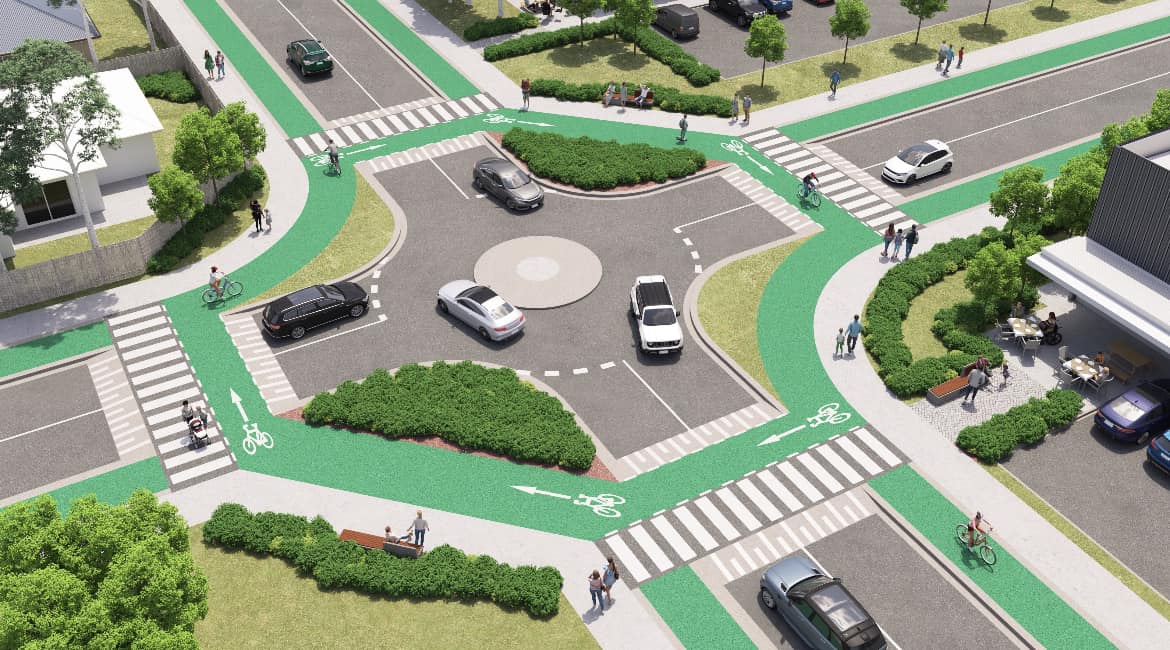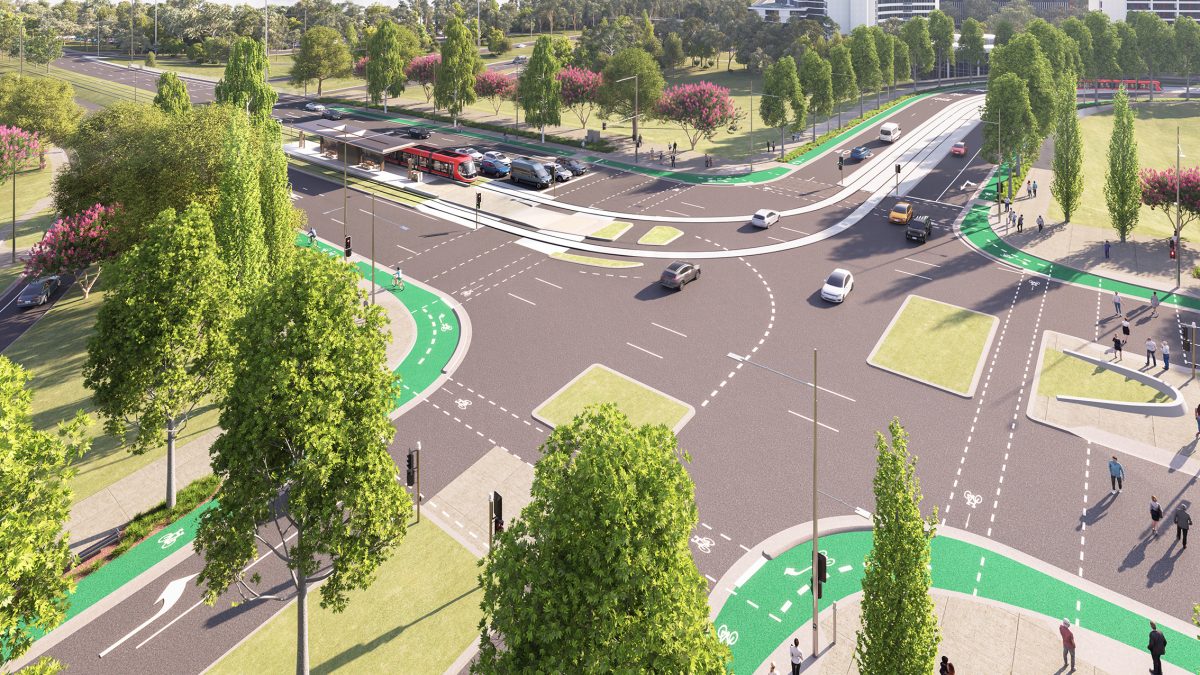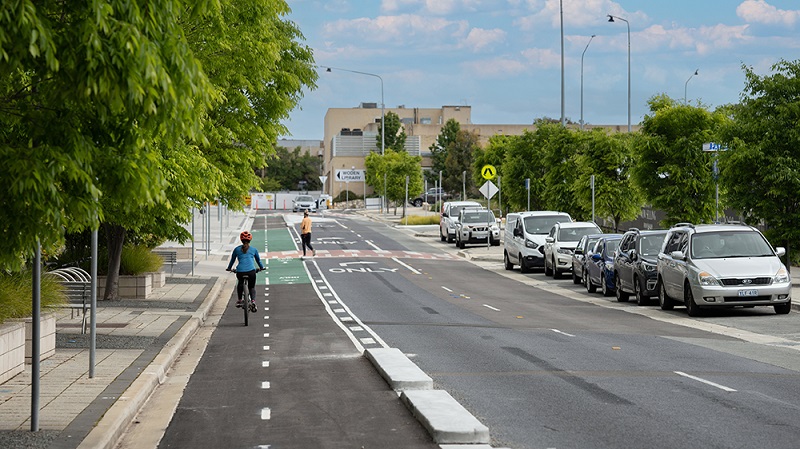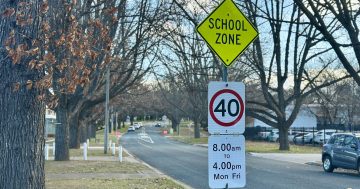
An artist’s impression of future ACT intersections. Image: ACT Government.
Canberra’s intersections will begin to look a lot like those in Europe under a new government plan.
The ACT Government’s draft ‘Design Guide’ calls for raised pedestrian crossings, coloured cycle paths, narrower roads and tighter corners to be rolled out across Canberra in an effort to slow down motorists and provide better protections for ‘active travel’ users.
“Canberra has great infrastructure for walking and cycling, but it does not always give priority to vulnerable road users in ways that will encourage more people to choose active travel,” the 35-page document reads.
“More Canberrans will walk and ride if it is safer, more accessible, convenient and comfortable. This starts with the basic design of our city’s streets.”
The guide outlines plans to encourage “drivers to be more observant” and separate “cyclists and other vulnerable users from road users with higher speeds and higher mass”.
“Tightening an intersection’s geometry through the use of kerb build-outs, sharp kerb radii, narrow lanes, and limiting the number of lanes all contribute to lower speeds,” the guide reads.
New roundabout designs aim to “reduce speed and give time to observe each conflict in turn” with raised pedestrian crossings and cycle paths ensuring motorists pause before entering.
Future slip lanes and large high-speed roundabouts are ruled out in favour of traffic lights to “minimise intersection footprint and pedestrian crossing times”.

Light Rail Stage 2A plans for the intersection of Commonwealth Avenue and London Circuit. Photo: ACT Government.
Intersection design should also prioritise public transport, and include signals that give buses a head start.
“The goal of the intersection should be to not strictly reduce the number of conflicts, but to ensure a space where street users are visible and predictable in their actions,” the guide reads.
Canberra’s current thoroughfares aren’t exempt either.
“Existing streets need to be assessed on an individual basis and require traffic calming if current speeds exceed survivable speeds.”
These heavily European-inspired design principles have already been put into practice during recent upgrades to the Tuggeranong and Woden town centres, but they’re set to become the new standard across Canberra in coming years.
ACT Transport Minister Chris Steel shared one of the sketches on his official Facebook page on 6 May as one of the “new best-practice designs for intersections in Canberra”.
“While every intersection won’t be retrofitted to look like this overnight, you can already see some of these design principles incorporated in our newer infrastructure projects, like Light Rail Stage 2A,” he said.
However, not everyone in the comments was so excited.
“This is a terrible design and will put lives at risk,” one said.
“It would be better to use traffic lights, as it would keep pedestrians and cyclists apart from moving vehicles.”
Another commenter cited “blockages and confusion” around similar intersections in Canberra, such as Furzer and Worgan streets in Phillip and Alinga and Moore streets in Civic.
“The intersections get blocked in all directions.”
One claimed to have experienced this in Geelong, Victoria: “With space for only one car in between the crossing and the roundabout, the traffic backs up a long way. It’s really annoying.”

New road design on show in Woden. Photo: ACT Government.
The National Transport Research Organisation (NTRO), also known as the Australian Road Research Board (ARRB), is a private transport advisory company owned by the state and territory transport agencies, with offices across all major cities including Canberra. CEO Michael Caltabiano says the biggest hurdle to the designs is “education”.
“It will take people some time to adapt,” he says.
“Canberra is a city designed for the car – you’re not going to be able to just turn that off. What you’ve got to do is change that over time to meet community expectations. And the answer is not all of one and none of the other. The answer is in how we integrate these journeys [with active travel].”
Mr Caltabiano expects the plans to “work really well”, especially in low-speed environments like Civic.
“Active transport users – cyclists, pedestrians, scooter riders – are most at risk at roundabouts because drivers are focussed on what’s coming on their right, what’s ahead, and entering and exiting the roundabout. What they inevitably miss is the pedestrian and cyclist.”
He says the new designs encourage motorists to “pause and let that active journey happen”.
Mr Caltabiano also says there is a “mountain of evidence” narrow road lanes help to reduce “the speed at which people feel they should be driving”.
“Where things don’t work is just changing a speed sign. Because if you’ve got wide, open lanes and you decide to make it 30 km/h, you’re going to be unsuccessful because there are no visual cues there.”
The draft Design Guide is open for community feedback on the YourSay Conversations website until Friday, 2 June.
Original Article published by James Coleman on Riotact.






